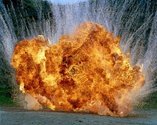John Hurrell – 17 June, 2009
Because of the nature of film as a medium and as a form of entertainment, there is a narrative involved; a narrative that often alludes to archetypes and myths which were around thousands of years before cameras were invented.
Auckland
Carolin Casey, Mhairi-Clare Fitzpatrick, James Lowe, Geoffrey H. Short, Dane Taylor
Still
Curated by Ariane Craig-Smith
28 May - 20 June 2009
There is something totalitarian about finding every gallery you stick your nose in is exhibiting photographs - so I for one will be pleased when the current festival is over. I don’t like any one medium dominating. I like to be surprised.
However the shows I’ve come across so far are very good. This one, curated by the 2007 ARTSPACE curatorial intern Ariane Craig-Smith, is of five senior photography students at Elam, and the theme, as referred to by the title, is film’s influence on photography. In the eighties this approach was widespread with the works of Cindy Sherman, Laurie Simmons, Richard Prince, Eileen Cowin and others. Sometimes direct quotation was involved. Sometimes it was more quoting a feeling rather than specific imagery.
With this exhibition the approach is wider. Often it is about the directorial setting up for a shot - the still that to the viewer seems to come out of a sequence. It involves hiring people, maybe actors, venues, props, lighting - or as in Geoffrey H. Short’s case, explosive experts.
Also, because of the nature of film as a medium and as a form of entertainment, there is a narrative involved; a narrative that often alludes to archetypes and myths which were around thousands of years before cameras were invented. In fact, the nature of narrative and certain patterns of conceptual construction found in the way we use language, are embedded in the properties of thought itself. So much so that according to cognitive scientist (and professor of English) Mark Turner, storytelling forms like parable for example, precede grammar. They don’t come after.
In other words, some filmic conventions of storytelling - and tropes like metaphor - can be seen as truly primal, referring to states that are even before language. I personally find this fascinating because it links some of the theories Len Lye had about certain forms of ‘Old Brain’ tribal image with the philosopher Donald Davidson’s essays on the properties of language and communication. Davidson says the notion of linguistic compentence is misleading, we don’t use shared rules, it is more complicated, and Turner’s ideas confirm this.
I’ve digressed. Getting back to the exhibition, Craig-Smith has chosen a surprising range of work, not all of it wall-based. Dane Taylor exhibits a superb little book of snapshots taken all round the world and mixed into its own logic. He has created a sequence where these rough and ready photos - without written explanation - are blended into a new continuum. Every now and then Taylor includes pages of written text describing dreams he has experienced, a clever foil to the quite mundane images (in isolation) he often presents.
Carolin Casey’s three images, compared to some of the other photos, lack glamour. Instead they emphasise the ordinary, even the shabby, and are closer to Harmony Korine than Brian de Palma. In the context of this show they invite you to speculate. Are they similar to some of Ann Shelton’s images in that they are documented scenes of crimes? Have bodies been buried or hidden here? Has unspeakable violence occurred?
Geoffrey H. Short’s three photos of explosions are astounding in their detail. Their acuity takes your breath away: the specks of shattered material suspended in mid air, the gorgeous wrinkly orange patterns in the heart of the fireball. One chromatically muted image is strangely like a painting - an early Hanly for example. Its dark, oddly shaped, smoky forms hovering in the air could have been scrubbed on with an oil-tipped brush.
The works most overtly referencing film come from Mhairi-Clare Fitzpatrick and James Lore. They use models and props. The former are especially important for Fitzpatrick, who sets up scenes where intense anxiety is shown in her female actor/models’ facial expression and body language. Her work is about interiority, the inner self, and alludes to contextual social narratives that impact on that.
In contrast, with James Lowe, the models are male, languid, not stressed, with props more akin to Californian conventions than New Zealand. The drama comes from a compositional staging of architectural elements, rather than psychological factors. Surprisingly there is a hint of the paranormal amongst the carefully staged imagery, with strange mists and odd shafts of theatrical lighting.
Despite the myriad references to film, this exhibition’s title obviously draws attention to the pleasures of the static. A contextualising sequence that you are aware of can be easily ignored if a stationary detail holds your gaze and you enjoy repeatedly returning to it. Even if each of these ‘stills’ had a DVD playing alongside - showing a filmed sequence out of which the photo was sampled - I imagine the presented images would still be compelling. This accomplished exhibition, with its catalogue and informative, lucid essay by Craig-Smith, is well worth a visit during a crisp winter’s lunchtime.
John Hurrell






 Two Rooms presents a program of residencies and projects
Two Rooms presents a program of residencies and projects Advertising in this column
Advertising in this column



This Discussion has 0 comments.
Comment
Participate
Register to Participate.
Sign in
Sign in to an existing account.